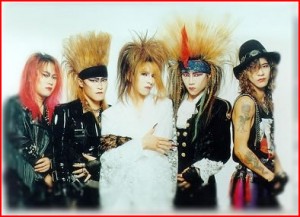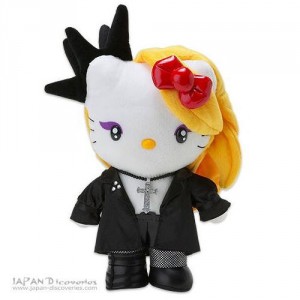In 2010, the Japanese Visual Kei band X Japan came to America. The group had been invited to perform in Chicago’s music festival, Lollapalooza, and were greeted by both their screaming fans and the incredibly confused representatives of the American media. A core cluster of questions seemed to plague the minds of all the uninitiated Americans who came into contact with them: “What is ‘visual kei’? How can it be understood in the context of American music? Why is it in America at all?” Studying not only the correct reply to these questions but also understanding why the questions arose at all reveals a lot about the barrier that still exists between Japan’s “gross national cool” and mainstream America.
The answer to “What is ‘visual kei’?” varies greatly depending on who is being asked, especially when those answering are outsiders or Westerners.
A Los Angeles Times article regarding the work of X Japan in the United States referred to the group as being a pop act, hard-rockers, and heavy metalists, all within the space of two paragraphs (Lee). Some believe that the genre has “roots in the style of androgynous and transvestite musicians like David Bowie” (Levi 248) while Yoshiki Hayashi, the face of the band and one of the two founding members, cites Kiss and Metallica as their biggest influences (Harris). What visual kei does have, regardless of origin or inspiration, is large, multi-colored hair, androgynous appearances, and heavy make-up. Just as Hello Kitty seems to attempt to reach a point of total mukokuseki, or statelessness, visual kei groups often seem to be trying to reach a point of total genderlessness.
Despite the predominately Western roots of the genre, however, the American media continued to regard X Japan as “a singularly Japanese brand of heavy metal thunder” (Lee). As though to emphasize this “Japaneseness,” every single news article that I managed to discover regarding Yoshiki in American newspapers made reference to the fact that Yoshiki is the first person to have a Hello Kitty doll modeled after him, the Yoshikitty. The seeming inseparable nature of Yoshiki and, through him, X Japan, from the “singularly Japanese” Hello Kitty shows that, though both the band and the doll strive to reach a point characteristicless-ness, neither actually succeeds.
Visual kei thus being a foreign phenomenon seemingly entirely beyond the understanding of the Western media, the language in which X Japan’s arrival was framed is fascinating. Not only are they “invading” Japan, as you can hear in an excerpt from Fox News’ coverage of the band, but they are “attempting” to make the cross over from “world music performers” to a “legitimate pop act” (Lee). Not only is this “singularly Japanese” band a foreign invasion, but they are not one with any perceived quality, defined instead solely by their foreignness. The existence of American fans of the band is either glossed over or ignored entirely. While Lee’s article discusses the promotional video filming X Japan held in Hollywood earlier in the year, he describes the eight thousand fans in attendance as people who had traveled “all the way from Japan for the event,” while adding as almost an after-thought that there were also “no small amount of American J-Rock enthusiasts in tow.” The American fans are thus portrayed as a minor, niche group, positioned as an “other” to the paper’s reader, the majority of whom who would not be “American J-rock enthusiasts.”
2010 was not the first year that X Japan attempted to break into the American market. In fact, their song IV is on the soundtrack for the movie “Saw IV” and topped the US iTunes daily chart in both the Overall Sales and Rock categories (Blabbermouth). Few of the articles regarding their 2010 reemergence make mention of this fact, however. They choose instead to frame the appearance of the band on the American consciousness as entirely out of left field and temporary. This framing reveals not only the reporters’ lack of understanding of the history and fanbase of the group, their impact on American culture already and the ways in which they have managed to amass fans overseas, but also their fear of the group’s success.
IV’s Promotional Video: [youtube]http://www.youtube.com/watch?v=LeyoxuhX-dQ[/youtube]
The genre of visual kei is undeniably an “other” to the mainstream American mindset. The style involves lots of cosmetics and lots of hair, and standing out as strongly as possible in ways that are not the acceptable, American ways to stand out. In fact, the style has a lot in common with that embraced by Lady Gaga, and the reaction of the mainstream media to her first appearance, especially the “damaging” rumors of her transsexuality, reveals that even American artists are slotted into a position of “other” when they attempt a similar look. A legitimately foreign artist trying the same therefore has even less of a chance of being viewed as acceptable.
However, no one can deny that Lady Gaga has achieved mainstream success in America. This success story does not offer X Japan the same sort of hope, however. While Gaga’s otherness only really became a factor after she had started becoming popular, X Japan’s otherness is present from the very beginning of their “invasion.” They are “taking on” the US, as the ABC article makes clear from its title, and are thus not merely trying to achieve fame and success but trying to steal it, in a way, as though they will only get it by taking it away from America.
In short, X Japan may try to enter into the American market, but the response of the American media to their show at Lollapalooza and their subsequent desire to tour reveals that they continue to be an “other” to mainstream America, just as Hello Kitty cannot help but remain “singularly Japanese” in spite of her mukokuseki nature. Not only are they “other,” however, but they are an “invading” other that the mainstream America continues to fear and strive to ignore. Essentially, Japanese culture still has a while to go before its “gross national cool” moves out of the American niche.
Discussion Questions:
Has “characteristiclessness” become something “singularly Japanese” to Americans?
Is the only value of X Japan that of “world music” or do they have value inherent as musicians as well?
Does X Japan stand any chance of becoming mainstream in America? What is the greatest obstacle to their success?
Related Links:
Article on the perceived fetishism of visual kei, written by a scholar in Austria: http://www.uri.edu/iaics/content/2007v16n1/10%20Miyuki%20Hashimoto.pdf
ABC News’ article on X Japan’s plan to tour the US in 2011: http://abcnews.go.com/Entertainment/wireStory?id=13090526
ABC News’ interview of Yoshiki: http://www.youtube.com/watch?v=8WBP55X9lGc
Fox News’ coverage of X Japan’s arrival: http://video.foxnews.com/v/4309782/x-japan-is-coming-to-america/
Sources:
“BLABBERMOUTH.NET – GUNS N’ ROSES Guitarist To Perform With X JAPAN In Tokyo.” Roadrunner Records | Official Home of Slipknot, Nickelback, Theory of a Deadman, Lenny Kravitz, Young the Giant, Lynyrd Skynyrd, Trivium, Megadeth, Dream Theater, and All the Best in Rock, Hard Rock, and Metal. 20 Mar. 2008. Web. 11 Mar. 2011. <http://www.roadrunnerrecords.com/blabbermouth.net/news.aspx?mode=Article&newsitemID=93306>.
Harris, Dan and Enjoli Francis. “Japan’s Bono: Yoshiki is Ready to Take on the U.S.” ABCNews 8-10-2010. 3-11-2011 <http://abcnews.go.com/WN/yoshiki-japans-bono-ready-us/story?id=11358722>.
Lee, Chris. “America, meet Yoshiki.” Los Angeles Times 7-25-2010. 3-11-2011 <http://articles.latimes.com/2010/jul/25/entertainment/la-ca-yoshiki-20100725>.
Levi, Antonia, Mark McHarry, and Dru Pagliassotti. Boys’ Love Manga: Essays on the Sexual Ambiguity and Cross-Cultural Fandom of the Genre. Jefferson, NC: McFarland &, 2008. Print.


Congratulations- you’ve found a topic about which I know next to nothing! Excellent post here.
I’m intrigued by the comparisons you draw between glam androgyny and mukokuseki here, because, although they both entail the obliteration of identifiers, the objective pursued in each appears to me to be radically different. While removing cultural markings, as in the case with Hello Kitty, serves the purpose of increasing a product’s familiarity and accessibility in a wide variety of contexts, the degendering that characterizes X Japan’s visual language seems deliberately tailored to lend them the air of an unsettling ‘other.’ In this way, mukokuseki and Visual Kei are positioned to take advantage of entirely different conceptions of Japanese cool: on the one hand, we have stylized immediacy, while on the other we see a studied transgression of norms, going so far as to create a fictive, androgynous ‘third gender.’ By this interpretation, might not the perception that Visual Kei bands are “invading,” particularly if it is endorsed by cultural reactionaries such as Fox News, be the very best endorsement of their potential (sub)cultural cachet in the West?
Also, can you explain a little further the distinction between Western glam/hair metal bands and Japanese Visual Kei groups?
As to your discussion questions:
In my mind, “World Music,” in all of its politically-correct finery, is a profoundly Orientalist construct, relying, as it does, on the assumption of Western music as a referential norm. Therefore, I would shrink from throwing any group or performer into that box, provided that they have a career outside of Putumayo compilation albums.
Second, I would contend that the greatest obstacle to Visual Kei’s acceptance in the US is the demise of glam metal in the early nineties: X Japan doesn’t elicit an impression of foreignness to me as much as it does one of datedness. Then again, there are plenty of successful bands in the US today that exploit an atmosphere of camp or kitsch, so I wouldn’t write them off completely.
Lastly, on the matter of mukokuseki as Japanese: I’m planning on doing some writing on this one, so I won’t steal too much of my own thunder here. Suffice it to say that I agree with your contention, with some caveats- Japan as cultureless and universal is one side of the picture. The other is Japan as ineffable and bizarre. Somewhere in between, we can feel out the edges of the Western conception of Japanese ‘cool.’ In this sense, Hello Kitty and Visual Kei, although not, I would argue, overly similar, are related: they bookend the extremes of benign statelessness and aggressive bizarrity that are bound up in Japanese soft power.
What an interesting topic you have Miriam! I had never heard of Visual Kei before reading your post, nor for that matter, had I heard of X Japan. I think their style definitely calls both David Bowie and Kiss to mind. In that vein of thought then, their look seemed more familiar to me then Lady Gaga (but maybe my parents just listened to too much classic rock when I was a child).
The way that X Japan has been talked about in the media is surprising. With such a distinct style orientalist otherizing hardly seems necessary! I’m curious, to what extent do Visual Kei groups actually strive to be “others?” What kind of reception have such groups had in Japan? I am also curious about the American fan base for X Japan. Do you have any idea how big it is or what kind of networks it has built?